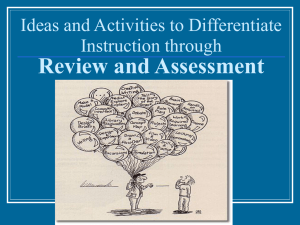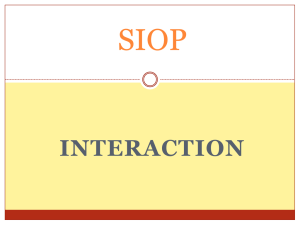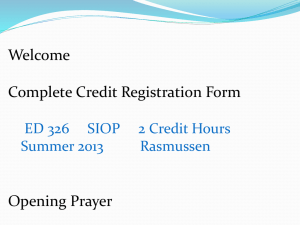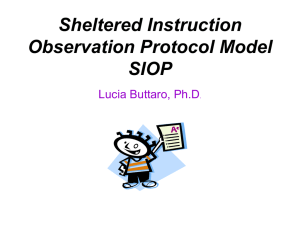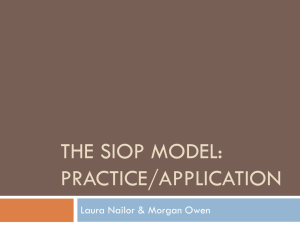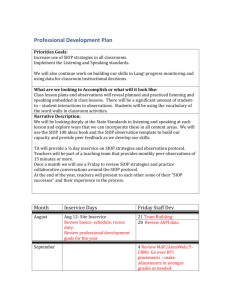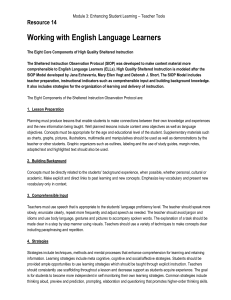SIOP is good teaching PLUS purposeful teaching of
advertisement
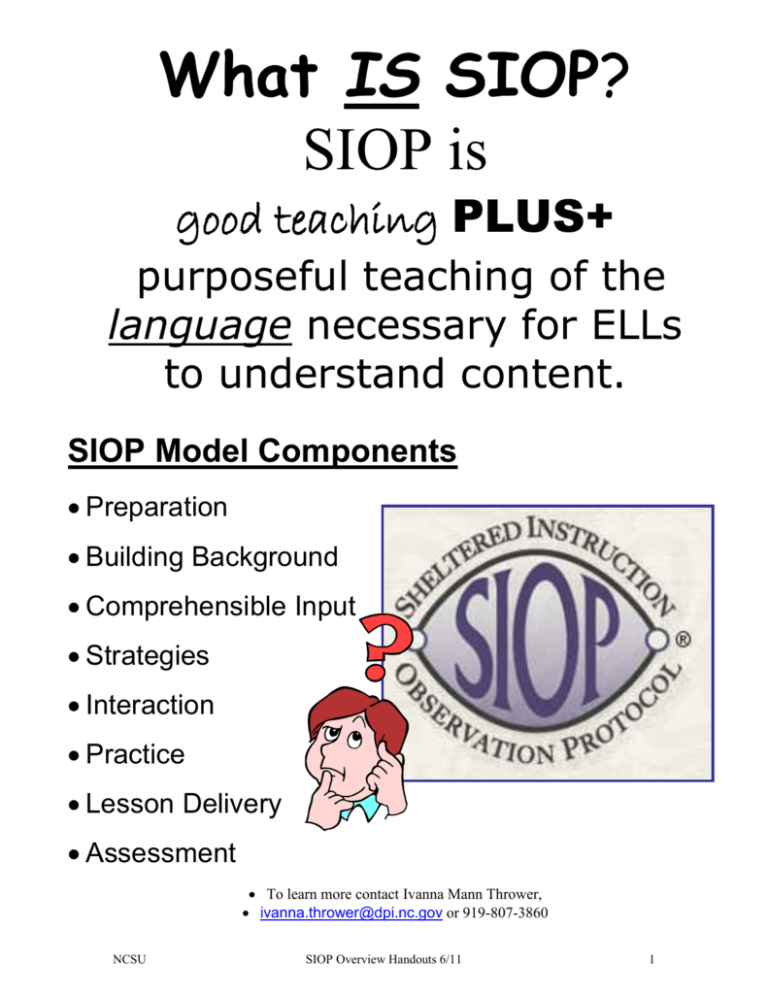
What IS SIOP? SIOP is good teaching PLUS+ purposeful teaching of the language necessary for ELLs to understand content. SIOP Model Components Preparation Building Background Comprehensible Input Strategies Interaction Practice Lesson Delivery Assessment To learn more contact Ivanna Mann Thrower, ivanna.thrower@dpi.nc.gov or 919-807-3860 NCSU SIOP Overview Handouts 6/11 1 SIOP LESSON PLANNING SHEET Name: _________________________________ Date: _________________ Assignment:_____________________________________ Lesson Preparation 1. Write content objectives clearly for students. 2. Write language objectives clearly for students. 3. Choose content concepts appropriate for age and educational background level of students. 4. Identify supplementary materials to use (graphs, models, visuals). 5. Adapt content (e.g., text, assignment) to all levels of student proficiency. 6. Plan meaningful activities that integrate lesson concepts (e.g., surveys, letter writing, simulations, constructing models) with language practice opportunities for reading, writing, listening, and/or speaking. Building Background 7. Explicitly link concepts to students’ backgrounds and experiences. 8. Explicitly link past learning and new concepts. 9. Emphasize key vocabulary (e.g., introduce, write, repeat, and highlight) for students. Comprehensible Input 10. Use speech appropriate for students’ proficiency level (e.g., slower rate, enunciation, and simple sentence structure for beginners). 11. Explain academic tasks clearly. 12. Use a variety of techniques to make content concepts clear (e.g., modeling, visuals, hands-on activities, demonstrations, gestures, body language). Strategies 13. Provide ample opportunities for students to use strategies, (e.g., problem solving, predicting, organizing, summarizing, categorizing, evaluating, self-monitoring). 14. Use scaffolding techniques consistently (providing the right amount of support to move students from one level of understanding to a higher level) throughout lesson. 15. Use a variety of question types including those that promote higher-order thinking skills throughout the lesson literal, analytical, and interpretive questions). Interaction 16. Provide frequent opportunities for interactions and discussion between teacher/student and among students, and encourage elaborated responses. 17. Use group configurations that support language and content objectives of the lesson. 18. Provide sufficient wait time for student responses consistently. 19. Give ample opportunities for students to clarify key concepts in L1 as needed with aide, peer, or L1 text. Practice/Application 20. Provide hands-on materials and/or manipulatives for students to practice using new content knowledge. 21. Provide activities for students to apply content and language knowledge in the classroom. 22. Provide activities that integrate all language skills (i.e., reading, writing, listening, and speaking). Lesson Delivery 23. Support content objectives clearly. 24. Support language objectives clearly. 25. Engage students approximately 90-100% of the period (most students taking part and on task throughout the lesson). 26. Pace the lesson appropriately to the students’ ability level. Review/Assessment 27. Give a comprehensive review of key vocabulary. 28. Give a comprehensive review of key content concepts. 29. Provide feedback to students regularly on their output (e.g., language, content, work). 30. Conduct assessments of student comprehension and learning throughout lesson on all lesson objectives (e.g., spot checking, group response.) Comments: NCSU SIOP Overview Handouts 6/11 2 Write/Talk about these 2 experiences … 1) List 5 different strategies that were used. 2) Tell a partner how you felt. 3) Draw pictures of the words you remember. 4) Tell your group about a time you purchased an echinated object. 5) What else could you do with this? Factors Affecting Second Language Acquisition (SLA) 1) Which ONE of factors below does a teacher have the most control over? 1st Language Development Access to Language Age Cultural Background Language Attitude Language Distance Learning Styles Motivation Peers/Role Models Personality Quality of Instruction 2) How does/should this affect planning and teaching? Write Content and Language Objectives that… will be read by students, for students will be easy for students to understand are given orally and in writing are related to the tasks necessary to master the content objective are tied to a specific grade-level content standard (NC SCS/Content Area) SIOPing Your Lessons: Preparing Language Objectives Connected to SCOS Content Objectives Content Objective Round 4-digit numbers to the nearest 10 or the nearest hundred. Analyze the changes the horse brought to the Plains peoples. Analyze how people decide what and how much to produce. Design and build a working model, using three or more of the simple machines studied. Determine which literary terms used in a text are effective. Provided by NCDPI ESL Department NCSU Language Objective Explain your answer to a partner using a number line. Role play scenes from the life of Plains people demonstrating how lives changed due to the horse. Use a tree diagram to explain to a partner how people decide what and how much to produce. Explain your model to a partner, naming and pointing to the simple machines used. Defend your choices in a small group discussion. SIOP Overview Handouts 6/11 3 Building Background Link concepts to students’ background experiences. Bridge past learning to new concepts. Emphasize key vocabulary. CMS Ivanna Mann Thrower 2008 Guidelines to Achieve Comprehensible Input 1. Use expression and body language to demonstrate concepts and directions 2. Speak slowly and clearly with pauses between phrases 3. Use short sentences with simple syntax. 4. Use action verbs. Analyze Describe List Solve Apply Explain Name Summarize Choose Predict Compare Give and example Define Identify Show Recommend 5. Repeat and Review Vocabulary. 6. Monitor comprehension through various strategies 7. Use visuals and graphic organizers 8. Communicate in oral, written, physical and pictorial formats 9. Provide hands-on and cooperative learning activities 10. Provide step-by-step modeling for academic tasks 11. Provide opportunities to apply knowledge in new contexts. Add your own here: NCSU SIOP Overview Handouts 6/11 4 Metacognitive Strategies “thinking about thinking” Predicting/Inferring Self-questioning Monitoring/Clarifying Evaluating Summarizing Visualizing Cognitive Strategies “active learning” Previewing/Rereading Establishing a purpose for reading Making connections Reading aloud Highlighting Taking notes Mapping information Finding key vocabulary Mnemonics Social/Affective Strategies “interactive learning” Interaction/questioning Cooperative learning Group discussion/self talk i.e.. Think/Pair/Share NCSU SIOP Overview Handouts 6/11 5 INTERACTION: Class Activities that Use Cooperative Learning 1. Jigsaw - Groups with five students are set up. Each group member is assigned some unique material to learn and then to teach to his group members. To help in the learning students across the class working on the same sub-section get together to decide what is important and how to teach it. After practice in these "expert" groups the original groups reform and students teach each other. (Wood, p. 17) Tests or assessment follows. 2. Think-Pair-Share - Involves a three step cooperative structure. During the first step individuals think silently about a question posed by the instructor. Individuals pair up during the second step and exchange thoughts. In the third step, the pairs share their responses with other pairs, other teams, or the entire group. 3. Three-Step Interview - Each member of a team chooses another member to be a partner. During the first step individuals interview their partners by asking clarifying questions. During the second step partners reverse the roles. For the final step, members share their partner's response with the team. 4. Round Robin Brainstorming - Class is divided into small groups (4 to 6) with one person appointed as the recorder. A question is posed with many answers and students are given time to think about answers. After the "think time," members of the team share responses with one another round robin style. The recorder writes down the answers of the group members. The person next to the recorder starts and each person in the group in order gives an answer until time is called. 5. Three-minute review - Teachers stop any time during a lecture or discussion and give teams three minutes to review what has been said, ask clarifying questions or answer questions. 6. Numbered Heads - A team of four is established. Each member is given numbers of 1, 2, 3, 4. Questions are asked of the group. Groups work together to answer the question so that all can verbally answer the question. Teacher calls out a number (two) and each two is asked to give the answer. 7. Team Pair Solo - Students do problems first as a team, then with a partner, and finally on their own. It is designed to motivate students to tackle and succeed at problems which initially are beyond their ability. It is based on a simple notion of mediated learning. Students can do more things with help (mediation) than they can do alone. By allowing them to work on problems they could not do alone, first as a team and then with a partner, they progress to a point they can do alone that which at first they could do only with help. NCSU SIOP Overview Handouts 6/11 6 INTERACTION: Class Activities that Use Cooperative Learning 8. Circle the Sage - First the teacher polls the class to see which students have a special knowledge to share. For example the teacher may ask who in the class was able to solve a difficult math homework question, who had visited Mexico, who knows the chemical reactions involved in how salting the streets help dissipate snow. Those students (the sages) stand and spread out in the room. The teacher then has the rest of the classmates each surround a sage, with no two members of the same team going to the same sage. The sage explains what they know while the classmates listen, ask questions, and take notes. All students then return to their teams. Each in turn, explains what they learned. Because each one has gone to a different sage, they compare notes. If there is disagreement, they stand up as a team. Finally, the disagreements are aired and resolved. 9. Partners - The class is divided into teams of four. Partners move to one side of the room. Half of each team is given an assignment to master to be able to teach the other half. Partners work to learn and can consult with other partners working on the same material. Teams go back together with each set of partners teaching the other set. Partners quiz and tutor teammates. Team reviews how well they learned and taught and how they might improve the process. Add Your Own: NCSU SIOP Overview Handouts 6/11 7 Practice/Application Quick Write How do you integrate activities in your classroom? 20. Provide hands-on materials and/or manipulatives for students to practice using new content knowledge. 21. Provide activities for students to apply content and language knowledge in the classroom. 22. Provide activities that integrate all language skills (i.e., reading, writing, listening, and speaking). Lesson Delivery: Teacher Behaviors Avoid Assuming prior knowledge Yes or no questions! Building Background Self-Correcting Immediately correcting the student Self-Evaluation Only grading for correct answers Peer Interaction Always giving the answer Imitation Silent classrooms Native Language Resources NCSU Assuming students will know how to use their dictionaries and glossaries SIOP Overview Handouts 6/11 Focus On Discovering prior knowledge Context clues Relating shared experiences Wait time Journals (can be illustrated!) KWL Charts Rubrics Phone a friend’, ‘poll the audience’ Pairing higher & lower level ELLs Listen to the radio Interviews Guest Speakers Clarification Teaching students when and how to use these resources 8 Assessment Modification: It’s NOT Unfair! It’s Essential! 1. Give students objective tests (matching, multiple choice, T or F) instead of subjective tests (essays). 2. Provide extra testing instructions or rephrase directions. 3. Test key concepts or main ideas (not specific points). 4. Make a simplified language test. 5. Supply ELLs with word banks for tests. 6. Reduce the number of test responses. 7. Simplify test directions. 8. Assess ELLs on their effort to understand content area material at their level of language ability. 9. Provide highlighted tests. 10. ________________________________________________________ 11._________________________________________________________ 12._________________________________________________________ OUTCOME SENTENCES NCSU I feel … I wonder … I think … I learned … SIOP Overview Handouts 6/11 9
